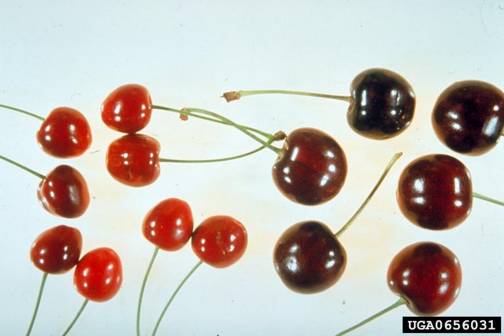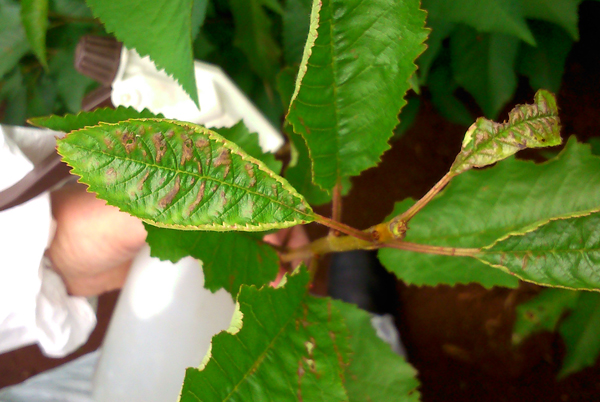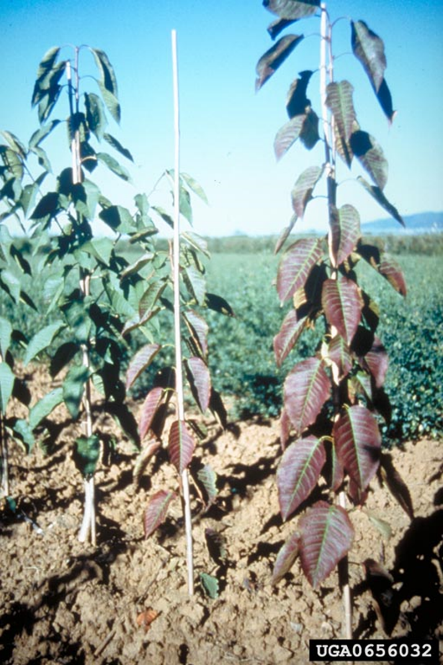Little cherry virus
Little cherry virus 2 (LChV2) is a plant virus that affects the overall health of a cherry tree and results in fruit that is small, poorly coloured and lacking flavour.
LChV2 was detected in Tasmania in January 2014 and has since been found in Victoria. It's now believed that the virus might have been in Australia for more than 35 years and could be widespread across the country. As a result, and based on scientific evidence, it's considered that LChV2 can't be eradicated from Australia.
Host plants
Little cherry virus 2 affects:
- sweet cherry (Prunus avium)
- sour cherry (Prunus cerasus)
Symptoms of LChV2
Fruit
LChV2 symptoms generally become visible as the fruit matures.

- LChV2 appears as smaller, discoloured, bitter tasting fruit that are unmarketable (Figure 1).
- Symptoms may not be uniform across all fruit on a particular tree and might only be seen on some fruit.
Leaves
Leaf symptoms of LChV2 aren't always apparent.

Reddening of leaves (Figure 2) may appear on some cultivars, such as:
- scions of Sam, Bing and Van
- rootstock of Lapin and Mazzard F12/1
Severe symptoms of reddening foliage can be found on the indicator cultivar Canindex 1 (Figure 3).

Climatic conditions
Anecdotally, symptoms seem to be more prevalent on cherry trees in the cooler climate of Tasmania than in the warmer climate of mainland Australia.
Spread of disease
LChV2 can be spread by the movement of:
- infected young trees
- rootstocks
- scions
- budwood.
It doesn't spread by moving cherries from infected trees.
Grafting from any part of an infected tree can transmit the virus.
Managing little cherry virus
To minimise the chances of LChV2 spreading and reducing saleable crop yields, there are several biosecurity actions growers can take to manage the virus. In additional to monitoring for symptoms, these include:
- good farm hygiene
- monitoring for insect vectors
- growing tolerant cultivars
- not importing host material.
If these are used widely enough across the industry, LChV2 could be eliminated as a significant disease threat.
Growing or importing host materials
Don't grow or import ornamental cherry species, especially cultivars of the oriental flowering cherry (Prunus serrulata). These can carry LChV2 without showing symptoms.
If possible, choose tolerant cultivars. At present, many of the European cultivars seem to be tolerant of LChV2.
Farm hygiene
- Use only propagation material of a known high health status from reputable suppliers.
- Test new stock coming onto the property for LChV2 (and other viruses) or specify that new stock must be tested and found negative before entering the property.
- Test stock already on the property for LChV2 and remove any found to be infected. Infected trees might not recover their health or productivity and could act as a reservoir for the virus. Also consider what other viruses your stock might need to be tested for, and when and how to do so.
- If trees need to be removed, cut them at the stump and apply a herbicide to kill the root system that remains. The best time to do this is when there's active growth (for example, spring treatment is less effective around plant dormancy).
- Don't swap cuttings with other growers or gardeners.
- Don't graft existing material onto certified new stock.
- Keep mother stock separate from other host plant material.
- Make sure all staff and visitors are instructed in and comply with your business hygiene requirements.
- Eliminate volunteer cherry seedlings in and near the orchard, as they can be symptomless carriers of LChV2.
Monitoring for insect vectors
Organisms that are responsible for spreading a disease are known as vectors of the disease. Overseas, LChV2 is spread within an orchard by the insect vectors:
- apple mealybug
- grape mealybug
While these insects aren't known to occur in Australia, it's important to collect evidence of any potential vector species, including other mealybugs and scale insects.
To do this:
- regularly check orchards and propagation stock for signs of LChV2
- take samples of any suspect material and submit them for identification
- keep good records of cultivars (rootstock and scion material) and their sources
- look out for other organisms that could be potential vectors and record details (what, where, when)
- take samples of potential vectors and submit them to us for identification
Identification and diagnosis
If you suspect you have found LChV2 or potential vectors of the virus, it is most important that the organism(s) be correctly identified. Agriculture Victoria's Crop Health Services (CHS) group can provide diagnoses on a fee-for-service basis.
When to take samples for diagnosis
- The best time to test for LChV2 is between late summer and leaf fall.
- Collect samples early in the week, keep them cool and send them as soon as possible after collection.
- Tag sampled trees so they can be re-sampled if required.
Taking your samples
- Select older cherry varieties rather than those that might have come through improvement programs.
- Select diseased trees and shoots rather than healthy material.
- If possible, randomly sample 4 to 5 shoots (1-year-old wood) from all around the tree. If there are leaves on the shoot sample, leave them attached.
- You can pool shoots from up to 5 trees to make 1 sample. Collect 3 to 4 shoots per tree and place in a ziplock bag. Repeat for each of the remaining trees. Place bags from each tree together into another larger ziplock bag.
Send your samples to us
Contact Crop Health Services for a specimen submission form:
- phone: (03) 9032 7515
- fax: (03) 9032 7604
- email: chs.reception@ecodev.vic.gov.au
Fill in the specimen submission form. In a plastic express post bag or by courier, send your form and samples to:
Crop Health Services Agribio Specimen Reception
Main Loading Dock
5 Ring Road
Bundoora, VIC, 3083
Call or email to tell CHS when the samples are on the way.
CHS can also provide routine testing of cherry plant stock.
Research and development into LChV2
Little is known about LChV2 in Australia but samples of leaves and potential vectors can help with ongoing research.
Reporting an unusual plant insect pest or disease
Report any unusual plant pest or disease immediately using our online reporting form or by calling the Exotic Plant Pest Hotline on 1800 084 881. Early reporting increases the chance of effective control and eradication.
Please take multiple good quality photos of the pests or damage to include in your report where possible, as this is essential for rapid pest and disease diagnosis and response.
Your report will be responded to by an experienced staff member, who may seek more information about the detection and explain next steps.
Report onlinePhoto credits
Figure 1 courtesy of L. Kunze, Biologische Bundesanstalt für Land- und Forstwirtschaft, Bugwood.org
Figure 3 courtesy of L. Kunze, Biologische Bundesanstalt für Land- und Forstwirtschaft, Bugwood.org
References
CABI/EPPO Cherry little cherry 'virus' Data Sheets on Quarantine Pests. Prepared by CABI/EPPO for the EU under Contract 90/399003 4pp.